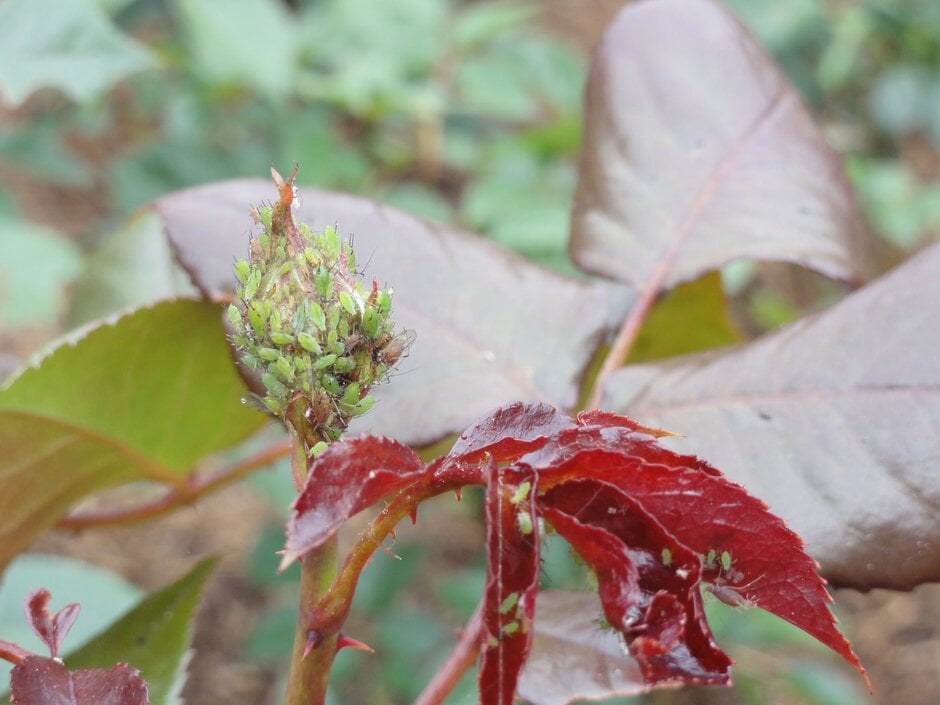Rose aphids
Roses can support large populations of sap sucking aphids (greenfly, blackfly and related insects) during spring and summer.

Quick facts
Latin name Several species, a common species is Macrosiphum rosae
Plants affected Wild and cultivated roses
Main symptoms Small green and/or pink insects clustered on the foliage, flower buds and shoot tips. Plants become sticky
Caused by Sap-sucking insects known as aphids or greenfly
Timing March-August
What are rose aphids?
Roses can support several species of aphid in the spring and summer, the most common is usually Macrosiphum rosae. This rose aphid can reach 3.5mm in length and varies in colour from pink to green, it can form dense colonies and produces large amounts of honeydew. Roses are also host to a root aphid, the root aphid does not appear to affect the health of roses.
Aphids are sap-sucking true bugs and are an important part of many food chains, supporting many predators. They range in size from 1 to 7mm (¼in or less) long. Some aphids are known as greenfly or blackfly, but there are species that are yellow, pink, white or mottled. There are more than 500 aphid species in Britain. Some feed on only one or two plant species, but others can be found on a wide range of plant hosts. Almost any plant can be a host, including ornamentals, vegetables, fruits, greenhouse plants and houseplants.
Symptoms
- Green or pink insects, cluster on the flower buds, shoot tips and young foliage
- White cast aphid skins are often seen on infested flower buds and leaves
- Flower buds and foliage can be covered in a sticky honeydew that aphids excrete
- Black sooty moulds may grow on the honeydew
Control
Aphids form the basis of many food chains in the garden and it is not unusual to have some of these animals in a healthy balanced garden ecosystem. Check roses frequently from spring onwards so action can be taken before a damaging population has developed. Natural enemies will normally reduce numbers by late summer. In addition artificial treatments are only likely to be successful if the entire plant can be reached. When choosing management options you can minimise harm to non-target animals by starting with the methods in the non-pesticide control section and avoiding pesticides. Within pesticides the shorter persistence products (that are usually certified for organic growing) are likely to be less damaging to non-target wildlife than those with longer persistence and/or systemic action. Pesticide treatments are likely to kill natural enemies and are only likely to be successful if the entire plant can be reached.
Non-pesticide control
- Where possible tolerate populations of aphids, they form an important part of many food chains and can be part of a healthy garden ecosystem
- Use finger and thumb to squash aphid colonies where practical
- Encourage aphid predators in the garden, such as ladybirds, ground beetles, hoverflies, parasitoid wasps and earwigs. Be aware that in spring aphid populations often build up before natural enemies are active in sufficient numbers and then give good control
Pesticide control
The RHS believes that avoiding pests, diseases and weeds by good practice in cultivation methods, cultivar selection, garden hygiene and encouraging or introducing natural enemies, should be the first line of control. If chemical controls are used, they should be used only in a minimal and highly targeted manner.- Organic sprays, such as natural pyrethrum (e.g. Bug Clear Ultra, Neudorff Bu2 g Free Bug and Larvae Killer) or plant oils (e.g. Vitax Plant Guard Pest & Disease Control, Bug Clear Fruit & Veg, Vitax Rose Guard) can give good control of aphids. These pesticides have a very short persistence and so may require reapplication to keep aphid numbers in check. Plant oil and fatty acid products are less likely to affect larger insects such as ladybird adults
- Plant invigorators combine nutrients to stimulate plant growth with surfactants or fatty acids that have a physical mode of action against aphids (e.g. Ecofective Bug Control, Growing Success Bug Stop, Rose Clear 3 in 1 Action SB Plant Invigorator and Westland Resolva Natural Power Bug & Mildew). These products contain some synthetic ingredients and so are not considered organic
- More persistent contact-action insecticides include the synthetic pyrethroids lambda-cyhalothrin (e.g. Westland Resolva Bug Killer), deltamethrin (e.g. Provanto Ultimate Fruit & Vegetable Bug Killer, Provanto Sprayday Greenfly Killer) and cypermethrin (e.g. Py Bug Killer)
- A systemic containing the active ingredient Flupyradifurone (Provanto Smart Bug Killer) is available
- The systemic neonicotinoid insecticide acetamiprid (e.g. Bug Clear Ultra) is also available
Plants in flower should not be sprayed due to the danger to bees and other pollinating insects
Inclusion of a pesticide product does not indicate a recommendation or endorsement by RHS Gardening Advice. It is a list of products currently available to the home gardener
Download
Pesticides for gardeners (pdf document)
Biology
Aphids usually overwinter on roses as eggs laid on the stems in the previous autumn. However, in sheltered places there may be active nymphs and adults all year round.
Aphid numbers start to increase in spring when roses are producing new growth and reach a peak in early summer. Some rose aphids are green but a common species, Macrosiphum rosae, is pink. During spring and summer, the aphids are mostly wingless forms, 2-3.5mm long, that give birth to live young.
Winged forms develop when plants are heavily affected and aphids need to migrate to new hosts.
See also...
Protect your garden
RHS statement on pesticides in horticulture
Influential points information on rose aphid, Macrosiphum rosae
Get involved
The Royal Horticultural Society is the UK’s leading gardening charity. We aim to enrich everyone’s life through plants, and make the UK a greener and more beautiful place.